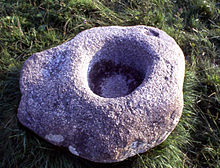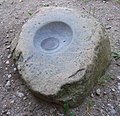Portlaun
Bullaun ( Irish bullán or bollán - from ( English bowl ; or French bol ) is the Irish name for a relatively deep, mostly hemispherical (hemispherical) hollow in a boulder or stone. The term bullaun (or bulla stone) also refers to the almost always low, usually only knee-high menhir - like or flat-round stone, which can also accommodate several (multiple) ( portlaun by Ardattin (2), Glebe I (3) both in County Carlow , Drummin (3), County Wicklow ), most of them have only one hollow, more than 300 bullauns are known in Ireland.
The term, although used sporadically in Scotland, does not have the same meaning and Scottish "bullwashes" have been largely overlooked. The distribution of bullauns in Scotland is difficult to determine because they have not been systematically recorded. The lack of interest is due in part to the following difficulties: simple form, uncertainty about its function and its delimitation - not entirely a monument, not entirely an artifact.
purpose
The original purpose of the bullion stones is unknown. They could have had a ritual significance as well as being utensils for cult purposes . Regularly shaped depressions can also occur due to erosion ( potholes , potholes , Tafoni ) so that depressions without appropriate context should not be classified as Bullaun. Bullaun stones are generally dated to the Bronze Age , but can also be older. They are particularly numerous in the Irish province of Leinster and there in the counties of Carlow (Busherstown) and Wicklow (Glendalough).
- Bullauns
The bullaun-like sacrificial stone of the Althof chapel near Doberan Monastery in Mecklenburg
References
There are over 150 registered bullauns in Ireland, mostly in Leinster , where 50 are found in County Wicklow alone , while they are rare in Ulster. In Killina, west of Tullamore in County Offaly in Ireland, there is a holy spring , a mass rock and a portlaun in close proximity. In the field by the church of Toureen Peacaun in County Tipperary lies the unusual low circular stone structure Beakan's Cell, four meters in diameter, within which two portholes lie. The larger one is irregular and does not appear to have been used for grinding. Mounted in the wall that surrounds these portlauns as protection is a small cross-slab , indicating that the structure is old.
The custom of the bullwash continued in the early Christian period under a different sign. Many have been found in connection with early Christian churches and monasteries (such as the Devenish monastery , on Holy Island in Lough Derg in County Clare ) or at holy wells . Their presence in these places indicates the esteem they held among the pre-Christian residents of Ireland and the efforts of the Christian Church to integrate them. Today, therefore, the discovery of a ballroom is viewed as an indication of the location of an old church building that has since disappeared.
The Saint Bridgids Stone in County Laois is an upright porthole with a "Kneelin stone" in front of it. Tradition has it that this is where people kneeled and prayed before kissing the stone.
In 2012, a round stone was discovered on the Scottish island of Canna with a simple Christian cross carved into the top. The stone, referred to in the media as cursing stone (" curse stone ") has a diameter of 25 cm and fits exactly into a recess in a cuboid bulla stone at the early Christian cross of Canna, which is why it was dated to around 800. Such stones that fit into bullaun recesses are called cursing stones and are associated with a popular belief that a curse (or a blessing) is said to have been pronounced when the stone is turned in its recess. Several rotating stones in their wells shows as St Brigid's Stone known Bullaun of Killinagh . Such stone pairs correspond to the combination of hand stone and bearing stone in Neolithic hand mills .
distribution
In Ireland, bullauns are found particularly in the province of Leinster , while they are rarely found in Connemara and Mayo . Bullauns are also found in England ( Cornwall ), Wales and Scotland ; under another name Les Pierres à Bassin (basin stones) in France or (Akmuo su debeniu, Šilalės Aukuro akmuo, Lūžų akmuo su dubeniu, near Zarasai) but also in Lithuania . Similar artifacts are common on mainland Europe, which are also known there as cup stones . Join dish-shaped depressions (Engl. Cups ) in combination with concentric petroglyphs on, we speak of cup-and-ring markings .
Bullaun is also the name of a village which is located near the Turoe Stone at Loughrea in County Galway .
See also
- Clonlisk portlaun
- Bullauns by Reananerree
- Roscam portholes
- Portlaun by Dromagorteen
- Gallen porthole
- Glacier Mill
literature
- Merit Åhs: Fran skålgrop till dopfunt? En kontinuitetsstudie av Ireland's bullaunstenar. Master's thesis Stockholm University 1998.
- Liam Price: Rock-Basins, or 'Bullauns', at Glendalough and Elsewhere In: The Journal of the Royal Society of Antiquaries of Ireland Vol. 89, No. 2 (1959), pp. 161-188
- Roger Mathieu: Le mystère des pierres à bassins . Editions Per Lous Chamis 1984.
Web links
- List of Bullau stones in Ireland (English)
- Irish Cross-Pillars and Cross-slab (English)
- Inch St. Lawrence, County Limerick; a portlaun in a stretched barrel-shaped stone - picture
- Killeenadeema East
- Lydacan Bullaun image
Individual evidence
- ^ William F. Falkiner: Bullaun. In: The Journal of the Royal Society of Antiquaries of Ireland , Fifth Series, Vol. 36, No. 4 (1906), pp. 420-421.
- ^ Seán Duffy (ed.): Medieval Ireland. To Encyclopedia. Routledge, New York 2005, p. 253
- ↑ 'Cursing stone' found on Isle of Canna , BBC News, May 19, 2012.
- ^ Killinagh Bullaun Stone , accessed February 12, 2013.






